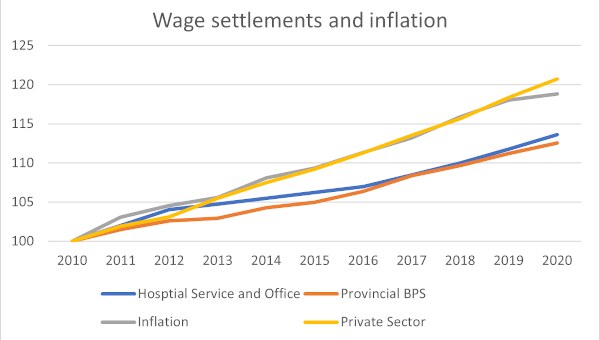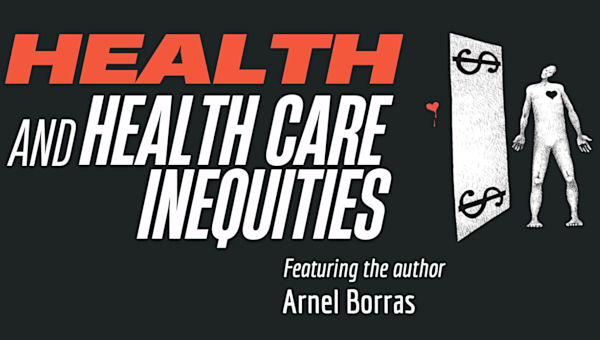Doug Ford and the PCs Plan Another Decade of Austerity
Ontario’s Financial Accountability Office (FAO) reports that the nominal healthcare funding increases planned by the Doug Ford PC government between 2019-20 to 2029-30 fall well short of the nominal increases over the previous nine years (2010-11 to 2019-20, the period of public sector austerity that followed the last recession).
Indeed, since the increase planned on a go-forward basis (between this year, 2021-22, and 2029-30) amounts to only 2% annually, we are looking at significantly harsher austerity than the 2010-11 to 2019-20 period, when funding increased 3.2% annually.
As the FAO notes, the healthcare austerity imposed over 2010-20 “included a number of significant spending restraint measures, including: freezing base operating funding for hospitals from 2012-13 to 2015-16; reducing physician payment rates in 2013 and 2015; and limiting investments in new long-term care beds, with only 611 new beds created between 2011 and 2018.”
This time around the plan is to impose harsher austerity while, at the same time, adding tens of thousands of new and redeveloped LTC beds, and increasing LTC staffing per resident by (roughly) 40 per cent.

Significant Reduction in Real Wages
Another aspect of the spending restraint over 2010-2020 was a significant reduction in real wages for hospital workers, as general wage increases fell behind inflation. For comparison, this chart also includes annual average wage settlements in the private sector and the broader provincial public sector (i.e., workers in hospitals, schools, colleges, the provincial civil services, etc).
Even before the pandemic, the government planned (via Bill 124) to cut real wages further by restricting wage settlements in the broader public sector to a level less than inflation for three years. The proposed funding – if implemented – would make further real wage cuts throughout the decade a necessity.
The FAO estimates a $5.7-billion gap between the health-sector funding plan and the required spending over the next two years (i.e., in 2022-23 and 2023-24). It notes: “The $5.7-billion cumulative spending gap is not distributed evenly among health sector program areas. The FAO estimates that a majority of the spending gap is in the hospitals program area” (my emphasis).
The FAO notes that if the government does implement its plans through 2029-30, “then annual real per capita health sector spending will have declined by $490 per person (or 10.2 per cent) since 2011-12.”
Cuts to Hospital Beds
Reports that the government plans to increase hospital beds in the years ahead are incorrect. The FAO notes that with 3,522 surge beds in 2021-22 we have 38,416 hospital beds. But as the FAO notes “the ministry’s spending plan for the hospitals sector implies that the 3,522 surge hospital beds will not be maintained after the pandemic ends.” As a result, the planned “addition” of 324 beds annually will only take us back to 37,321 beds by 2029-30. In other words, the real plan is to cut existing hospital beds by 1,095 beds. Yet, Ontario has very low bed capacity already, so the surge beds should not be removed, and we should build capacity from there.
Likely, the bed cuts will be covered up, as cutting beds is very unpopular with the public. That’s why finding and identifying the cuts when they happen is key.
The FAO estimates that if hospitals operate 11% above pre-pandemic volumes for surgeries and 18% above for non-emergent diagnostic procedures, it will take a full 3.5 years to clear the surgery backlog that has arisen during the pandemic and more than three years to clear the diagnostic backlog. However, the FAO notes that the government has allocated less than half of the $1.3-billion in funding necessary to achieve even this. The resulting suffering and illness these delays will impose on the sick is going to be considerable.
Finally, the FAO reports that in the Budget Estimates there is a planned decrease of $4.8-billion in the Operation of Hospitals transfer payment this year. The government believes this will be partially offset by a hoped-for increase of $1.0-billion (to be achieved, apparently, through increased private payments to hospitals for things like parking and semi-private accommodation). These cuts this year are related to the (hoped for) easing of the pandemic and are separate from the austerity plans for the years ahead discussed above. This will have a very negative impact on employment levels at hospitals. What is not clear is what will happen if a fourth wave occurs in the fall.
Doug Ford and the PCs campaigned in the last election on remarkably few promises – but one of them was to end hallway healthcare. Yet, at the start of the pandemic – almost two years into their mandate – they had made little progress improving hospital capacity. Accordingly, the government reacted to the lack of hospital capacity at the start of the pandemic by moving patients out of hospitals and into LTC facilities. However, the LTC homes were already crowded, so this compounded the COVID crisis in LTC facilities, with tragic results. In addition, LTC residents with COVID were rarely transferred out to hospitals for treatment. They died in their LTC beds even though LTC homes are not treatment facilities.
Even after that experience, instead of addressing the lack of capacity, the plan is harsh austerity. No doubt, they will attempt to cover this up with magical claims about how their reforms will overcome the lack of funding. But the past is a better guide: the latest reforms will have a similar level of success as all the many previous rounds of restructuring – restructuring that the present government has mostly dismissed and consigned to history.
As with past governments, austerity is the policy, and restructuring is the excuse the government gives to justify austerity.
Unless we change this plan, austerity will be applied not just in healthcare but in other sectors as well – likely more harshly than in healthcare, because healthcare is an area on which even right-wing politicians fear to tread. Notably, the FAO recently reported that another politically popular sector – public schools – would face a shortfall of $12.3-billion over nine years.
The government is playing with fire: one decade of austerity tests the limits of popular patience. Two decades takes it to a whole new level. •
This article first published on the OCHU Leftwords website.





